38 indian writing in english.
- 1. Plot of The Paly The Purpose Name : C. Amrutha Roll number : 38 Paper : Indian Writing In English Semester : 1 Department : English M. K. University , Bhavnagar
- 4. Eklavya as a Protagonist Arjuna is marginal ised An Ideal Disciple The Purpose Talent V/S Learning Role of Caste Discrimin ation Purpose to become a great Archer
- 5. Eklavya’s thumb cutting scene. Pandavas practising to become warriors. Eklavya repenting for his act.
- 6. Downfall of a hero Tragedy Hamarti a: Error of judgemen t Arousin g pity and fear
- 7. Definition. Tragedy, then, is an imitation of an action that is serious, complete, and of a certain magnitude; in language embellished with each kind of artistic ornament, the several kinds being found in separate parts of the play; in the form of action, not of narrative; with incidents arousing pity and fear, wherewith to accomplish its katharsis of such emotions. Aristotle.
- 8. Imitation 1. 2. 3. of an action that is serious • Eklavya • Imitating the action of thumb cutting scene. • Arjuna • Imitating the action of target viewing scene. • Dhronacharya • Imitating the action of teaching his Prince disciples.
- 9. Structure of the play • In the INCENTIVE MOMENT , the cause is down • • • • • played and the effect is emphasised. The CATASTROPHE is caused by the earlier incidents that took place. In the RESOLUTION moment, the EFFECT IS EMPHASISED AND THE CAUSE IS DOWN PLAYED. The THEORY OF UNITIES are broken by T.P. Kailasam. Although there is no use of deus ex machina, but we see the duo in Act 2, reaching the forest of Eklavya as a coincidence. There is a complex plot in the play as we see Peripeteia and Anagnorisis .
- 10. Catharsis










